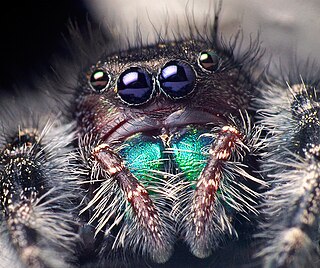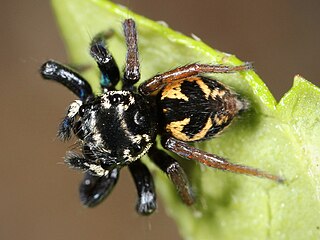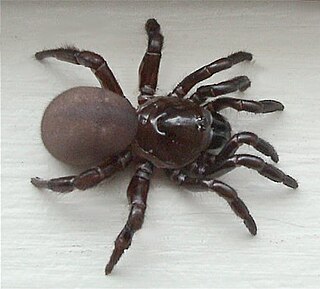
Phidippus is a genus in the family Salticidae. Some of the largest jumping spiders inhabit this genus, and many species are characterized by their brilliant, iridescent green chelicerae. Phidippus is distributed almost exclusively in North America, with the exception of two exported species. As of January 2021, there were about 80 described species in the genus. Species previously described in Phidippus which are found in India and Bangladesh do not belong in this genus.

Habronattus is a genus in the family Salticidae. Most species are native to North America. They are commonly referred to as paradise spiders due to their colorful courtship ornaments and complex dances, similar to birds-of-paradise.

Corythalia is a genus of jumping spiders that was first described by Carl Ludwig Koch in 1850.

Metacyrba is a genus of jumping spiders that was first described by Frederick Octavius Pickard-Cambridge in 1901. The name is combined from Ancient Greek μετά "after, beside" and the salticid genus Cyrba.

Metaphidippus is a genus of jumping spiders that was first described by Frederick Octavius Pickard-Cambridge in 1901. The name is combined from Ancient Greek μετά "after, beside" and the salticid genus Phidippus.
Sidusa is a genus of jumping spiders that was first described by George and Elizabeth Peckham in 1895.

Coneweb spiders (Diguetidae) are six-eyed haplogyne spiders that live in tangled space webs, fashioning a cone-like central retreat where they hide and lay eggs. It is a small family, containing only two genera with fifteen species and is confined to the New World, preferring deserts. Members of the genus Diguetia usually build their webs in shrubs or between cactus pads. They have the same eye arrangement as the venomous recluse spiders, but none are known to be harmful to humans.

Metepeira is a genus of orb-weaver spiders first described by F. O. Pickard-Cambridge in 1903. The name is derived from the Ancient Greek μετά and the obsolete genus name Epeira, denoting a genus similar to Epeira.
Melpomene is a genus of funnel weavers first described by O. Pickard-Cambridge in 1898. They range from southwestern U.S. to Panama and can grow up to 7 to 8.5 millimetres long. Roth and Brame noted that, with many undescribed species, the genus appears to be a catchall or "wastebasket taxon" for several unrelated species that may represent several genera.

Ummidia is a genus of mygalomorph spiders in the family Halonoproctidae, and was first described by Tamerlan Thorell in 1875.

Dictyna is a genus of cribellate araneomorph spiders in the family Dictynidae, and was first described by Carl Jakob Sundevall in 1833.
Ceratinopsis is a genus of dwarf spiders that was first described by James Henry Emerton in 1882.

Novalena is a genus of North American and Caribbean funnel weavers first described by R. V. Chamberlin & Wilton Ivie in 1942.

Elaver is a genus of sac spiders first described by Octavius Pickard-Cambridge in 1898.

Emblyna is a genus of cribellate araneomorph spiders in the family Dictynidae, and was first described by R. V. Chamberlin in 1948.

Trachelas is a genus of araneomorph spiders originally placed with the Trachelidae, and later moved to the Corinnidae.

Eustala is a genus of orb-weaver spiders first described by Eugène Simon in 1895.

Grammonota is a genus of dwarf spiders that was first described by James Henry Emerton in 1882.















